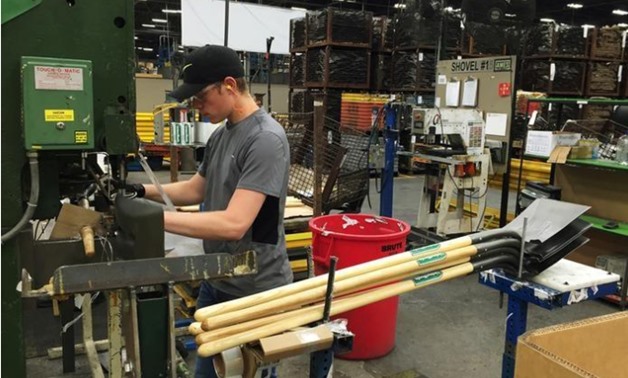
A production line employee works at the AMES Companies shovel manufacturing factory in Camp Hill, Pennsylvania, U.S. on June 29, 2017. Picture taken on June 29, 2017 - REUTERS/Tim Aeppel/File Photo
WASHINGTON - 1 November 2017: A measure of U.S. factory activity retreated from a 13-1/2-year high in October as the boost from hurricane-related supply disruptions faded, but continued to point to strengthening manufacturing conditions.
Other data on Wednesday showed a surge in private sector hiring, indicating that job growth rebounded last month after being depressed in September as hurricanes Harvey and Irma left some workers temporarily unemployed.
Manufacturing and labor strength likely keep the Federal Reserve on track to increase interest rates in December. The U.S. central bank is not expected to raise rates when policymakers conclude a two-day meeting later on Wednesday.
The Institute for Supply Management (ISM) said its index of national factory activity slipped to a reading of 58.7 last month from 60.8 in September, which was the highest since May 2004. A reading above 50 in the ISM index indicates growth in manufacturing, which accounts for about 12 percent of the U.S. economy.
September’s jump in the index was driven by supply chain disruptions, especially in the chemical products sector. The supply bottlenecks, which also pushed up prices of raw materials, resulted in a longer delivery times.
Longer suppliers’ delivery times are normally associated with increased activity, which is a positive contribution to the ISM index. The ISM’s supplier deliveries sub-index fell to 61.4 last month after soaring to 64.4 in September.
The survey’s prices paid sub-index dropped to 68.5 after racing to 71.5 in September, which was the highest reading since May 2011. The production sub-index slipped 1.2 points to a reading of 61.0 in October and a gauge of new orders fell to 63.4. A measure of factory employment dipped to 59.8 from 60.3 in September, which was the highest level since 2011.
Manufacturing is being supported by a strengthening global economy and weakening U.S. dollar.
PRIVATE PAYROLLS SURGE
Separately, the ADP National Employment Report showed private employers hired 235,000 workers last month, the most in seven months, after increasing payrolls by 110,000 jobs in September.
The ADP report, which is jointly produced with Moody’s Analytics, is not a good predictor of the private payrolls component of the employment report. It, however, supported expectations of a sharp rebound in employment last month after nonfarm payrolls declined by 33,000 jobs in September.
Prices for U.S. government bonds were trading higher and the dollar rose against a basket of currencies.
A third report from the Commerce Department showed construction spending increased 0.3 percent to $1.22 trillion as a surge in public construction outlays offset the third straight monthly decline in investment in private projects.
But August’s construction outlays were revised down to show a 0.1 percent gain instead of the previously reported 0.5 percent rise. Construction spending increased 2.0 percent on a year-on-year basis.
In September, investment on private construction projects fell 0.4 percent after slipping 0.1 percent in August. It was the third straight monthly drop in private construction outlays and reflected a 0.8 percent decline in spending on private nonresidential projects. Spending on nonresidential projects in September was the lowest since April 2016.
Spending on nonresidential structures has now declined for four consecutive months. Spending on oil drilling has been slowing in recent months amid moderate gains in oil prices and ample crude supplies. Spending on residential structures was unchanged in September.
The data could impact the government’s gross domestic product estimate for the third quarter published last week. The government’s advance estimate put economic growth at a 3.0 percent annualized rate in the July-September quarter, with both residential and nonresidential structures subtracting from output.
In September, outlays on public construction projects jumped 2.6 percent after rising 0.7 percent in August. Spending on state and local government construction projects climbed 2.5 percent. Federal government construction spending soared 3.4 percent.

Comments
Leave a Comment